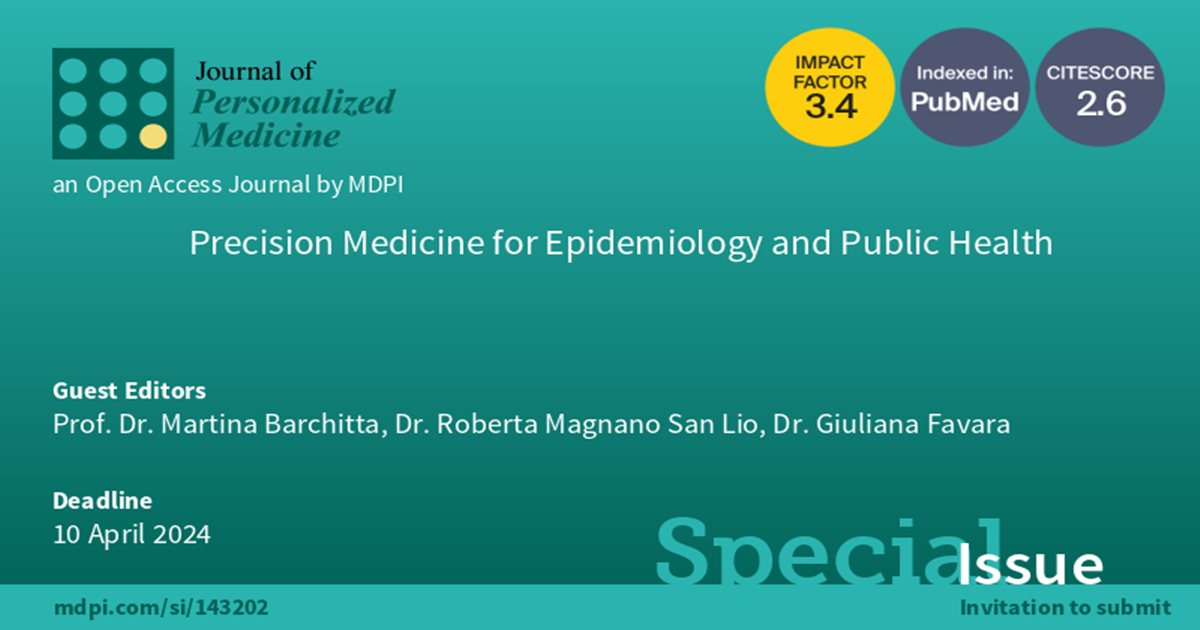Precision Medicine for Epidemiology and Public Health
A special issue of Journal of Personalized Medicine (ISSN 2075-4426). This special issue belongs to the section "Epidemiology".
Deadline for manuscript submissions: closed (10 April 2024) | Viewed by 10434

Special Issue Editors
Interests: public health; epidemiology; precision nutrition; nutrigenetics; nutrigenomics; nutriepigenomics; molecular biomarkers
Interests: public health; epidemiology
Special Issue Information
Dear Colleagues,
Precision medicine represents an emerging field for the early identification of those factors (e.g., biological, genetic and epigenetic, social, environmental, and clinical factors) that have a greater impact on people’s health and wellbeing. In this scenario, precision medicine—supported by a large amount of health data—could guide epidemiology and public health issues through the development of novel and more targeted preventive strategies.
In this scenario, the proposed Special Issue aims to provide novel insights into the role of precision medicine in human health and public health issues.
In recent decades, there has been an increased interest in the field of precision medicine, especially in accurately identifying effective treatments and preventive strategies targeted toward at-risk groups. Recently, an explosion of healthcare data and advances in smart technologies provide epidemiologists with the instruments for applying precision health, both in preventing disease and promoting health.
Here, we aim to provide an overview of the opportunities and challenges concerning the application of precision medicine in the fields of epidemiology and public health, through original research, reviews, and communications.
Prof. Dr. Martina Barchitta
Dr. Roberta Magnano San Lio
Dr. Giuliana Favara
Guest Editors
Manuscript Submission Information
Manuscripts should be submitted online at www.mdpi.com by registering and logging in to this website. Once you are registered, click here to go to the submission form. Manuscripts can be submitted until the deadline. All submissions that pass pre-check are peer-reviewed. Accepted papers will be published continuously in the journal (as soon as accepted) and will be listed together on the special issue website. Research articles, review articles as well as short communications are invited. For planned papers, a title and short abstract (about 100 words) can be sent to the Editorial Office for announcement on this website.
Submitted manuscripts should not have been published previously, nor be under consideration for publication elsewhere (except conference proceedings papers). All manuscripts are thoroughly refereed through a single-blind peer-review process. A guide for authors and other relevant information for submission of manuscripts is available on the Instructions for Authors page. Journal of Personalized Medicine is an international peer-reviewed open access monthly journal published by MDPI.
Please visit the Instructions for Authors page before submitting a manuscript. The Article Processing Charge (APC) for publication in this open access journal is 2600 CHF (Swiss Francs). Submitted papers should be well formatted and use good English. Authors may use MDPI's English editing service prior to publication or during author revisions.
Keywords
- epidemiology
- precision medicine
- precision public health
- human health
- risk factors
- prevention
- diseases






